Select Language
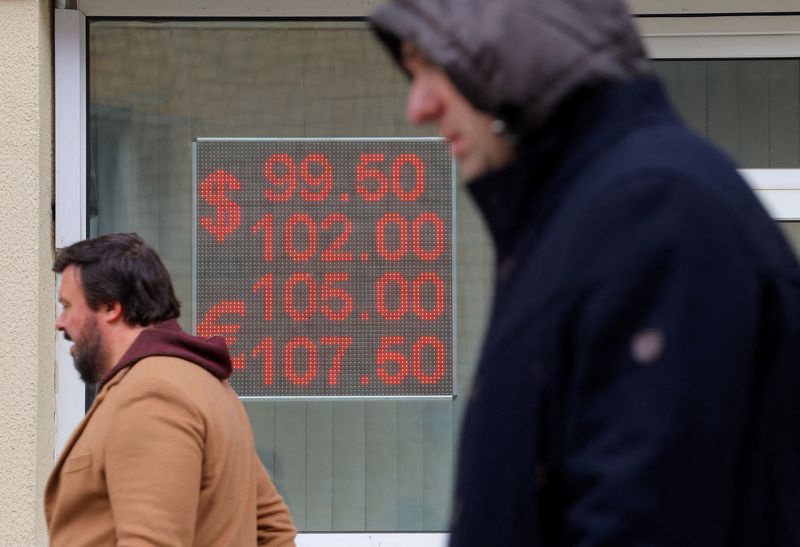
By Darya Korsunskaya and Alexander Marrow
(Reuters) - Russia could miss its 2024 revenue target and be forced to hike business taxes if the rouble proves stronger than expected in the budget and optimistic economic assumptions fall short, analysts warned, as Moscow spends more on its war in Ukraine.
Budget plans published in September envisage Brent crude prices averaging $85 per barrel next year - more pessimistic than a Reuters poll forecast - and a Urals price of $71.3.
But Russia's Accounts Chamber, which oversees budget execution, warned on Monday there were risks the Urals price would fall below $60 in 2024-2026.
Meanwhile, the West is keen to stop Russia from circumventing its $60-per-barrel oil price cap. Washington last week imposed the first sanctions on owners of tankers carrying Russian crude priced above that level.
The government is also relying on the currency remaining weak, which - while fanning inflation and eroding people's savings - raises the rouble value of energy revenues received in dollars.
"Next year's budget is very ambitious," said Expert RA Chief Economist Anton Tabakh.
"The deficit problem has been solved by the weak rouble. If the rouble appreciates strongly then the budget will be in a difficult position."
The rouble leapt off more than 18-month lows to the dollar last week after President Vladimir Putin ordered the mandatory sale of some foreign currency revenues for certain exporters.
It now trades at around 97 per dollar, softer than the budget's average forecast for 2024 of 90.1. The currency is historically weak, however, having rarely traded above 80 before Russia's invasion of Ukraine.
Finance Minister Anton Siluanov on Monday highlighted the risks of any strengthening, saying: "A change in the exchange rate by one rouble will lead to an increase or a decrease in budget revenues (of) around 100 billion roubles."
ARTISTIC APPROACH
Revenues are expected to climb 22.3% year-on-year to 35.1 trillion roubles next year, or 19.5% of gross domestic product.
Promsvyazbank analyst Denis Popov said that was possible but warned there are risks that oil and gas revenues especially could fall short.
Russia's forecast sees economic growth of 2.3% in 2024, well above estimates of 1.1% from the International Monetary Fund and 0.5%-1.5% from the Bank of Russia.
CentroCreditBank economist Yevgeny Suvorov described the budget as an artistic approach to realising strategic goals.
"There was a task to finance military expenditures, but also ... to show a return to the budget rule framework in 2025," Suvorov said.
"For this, it was necessary to depict rapid income growth. The best tool for this is the forecast they've drawn up."
Russia is walking a budget tightrope, and lower-than-expected energy revenues or GDP growth could prove costly.
"The revenue forecast, in our opinion, looks optimistic, both from the point of view of the economic prerequisites in he economy ministry's forecasts, and the preconditions for collection," said Renaissance Capital economists Sofya Donets and Andrei Melaschenko. They predicted an income shortfall of 1 trillion roubles.
Higher non-oil-and-gas revenues have helped narrow the deficit this year, but economist Dmitry Polevoy noted that the budget anticipated them weakening in future years, which could force the central bank to keep interest rates high.
"Risks for the non-oil-and-gas deficit are clearly skewed towards higher values," said Polevoy.
The central bank, which has hiked borrowing costs by 550 basis points since July and expects elevated rates for some time, has itself noted the government's optimism, saying the finance ministry's projections envisage a higher non-oil-and-gas surplus than its own macroeconomic forecast sets out.
CHANGING TUNE
At Russia's flagship economic forum in St Petersburg in June, Siluanov said increasing expenditure was difficult, as budget spending had already increased by 1-1/2 times from 2019 to 2022. Spending in 2024 is set to be double 2019's figure.
A bigger deficit would mean higher inflation and interest rates, the finance minister said, for which the population and business would pay. Taxes could also rise.
"If we want more spending, you have to understand where the money is coming from," Siluanov said. "Money doesn't come out of thin air."
Now, even as the government outlines plans for spending to jump to 36.7 trillion roubles in 2024, he is more relaxed.
"(It's a) fine, healthy budget, the temperature is fine," Siluanov said in September.
Russia has raised taxes on oil and gas firms by around 3.6 trillion roubles ($37 billion) in 2023-2025 and imposed a windfall tax on some company profits. Analysts expect more new taxes to cover any revenue shortfalls.
"Resources are finite. Experience shows that business, rather than citizens, will be actively sheared," said Expert RA's Tabakh.
Renaissance Capital's Donets and Melaschenko said Russia could create temporary taxes, permanently increase rates of VAT, or adjust Russia's budget rule to permit more spending of energy revenues.
Deputy Finance Minister Alexei Sazanov said in September that solutions were needed in response to higher spending.
"Tax tactics are having to become adaptive," Sazanov said. "These are the realities in which we live."
University of Chicago economist Konstantin Sonin said the key unknown for Russia's public finances is how much longer it will have to budget for war.
"They could survive a year or two, maybe five years, but this is setting the whole country, the whole budget, on a very wrong path," he said. "It's certainly not sustainable in the long run."
($1 = 97.3050 roubles)
(Graphic by Sumanta Sen; Additional reporting by Mark Trevelyan; Writing by Alexander Marrow; Editing by Catherine Evans)

By Hyunjoo Jin, Akash Sriram and Joseph White
(Reuters) -Tesla CEO Elon Musk said on Wednesday that he was concerned about the impact of high interest rates on car buyers, adding the electric vehicle maker was hesitating on its plans for a factory in Mexico as it gauges the economic outlook.
After the company missed Wall Street expectations on third-quarter gross margin, profit and revenue, Musk said he was cautious about going "full tilt" on the Mexico factory.
"If the macroeconomic conditions are stormy, even the best ship is still going to have tough times," he said in a shift in tone from a year ago, when he said Tesla (NASDAQ:TSLA) was "recession resilient."
Shares in the company fell more than 4% in after-hours trading on Wednesday. They had closed down 4.8%.
Tesla has managed to maintain demand with a series of price cuts, but Musk spent much of the call voicing concerns about further expansion, saying that he was afraid rising interest rates would make cars unaffordable.
The price of the popular Model Y SUV was "almost unchanged" for consumers even after Tesla's price cuts, Musk said, accounting for higher financing costs.
The automaker in March announced plans for a new factory in Mexico's northern state of Nuevo Leon that the state government estimated would cost more than $5 billion, though Tesla has yet to share a capital cost forecast.
Pressed for details on the factory, Musk said: "I am scarred by 2009 when General Motors (NYSE:GM) and Chrysler went bankrupt."
He also said there would be "enormous challenges" in reaching volume production for Tesla's long delayed Cybertruck pickup and making it cash flow positive.
PRICE CUTS
Tesla's aggressive price cuts this year have battered its gross margin, particularly in China where it faces stiff competition from local automakers.
The company is trying to survive the price war it started, mopping up any global demand for electric cars even as high interest rates and lower price tags at some rivals mute EV sales. Some analysts have said it may need to cut prices further to achieve its annual production target.
In the third quarter ended September, gross margin fell to a more-than four-year low and the company signaled it would keep cutting production costs to boost profits.
Still, it stuck to its annual production target of 1.8 million cars, a sign that the price cuts were buoying demand to an extent.
"The big question is if this is just a blip, or signs of a bigger shift among consumers as rising interest rates and a weaker economic backdrop discourage consumers from making big-ticket purchases," said Jesse Cohen, senior analyst at Investing.com.
Its stock has more than doubled this year after a slump last year as investors bet the company will fare better than rivals in an uncertain economy and get a long-term margin boost from its self-driving software. But the shares are still about 40% lower than its record high reached in 2021.
MARGIN FALLS
Tesla's gross margin dropped to 17.9% in the quarter ended September, compared with 25.1% a year earlier, when it had yet to start cutting prices. In the second quarter, Tesla had posted a gross margin of 18.2%.
Wall Street had on average expected Tesla to post a margin of 18.02%, according to 21 analysts polled by Visible Alpha. According to LSEG data, an average of 17 analysts polled expected 18.25%.
Automotive gross margin, excluding regulatory credits - a closely-watched figure - fell to 16.3% in the third quarter from 18.1% in the second quarter.
Margins fell despite a roughly $2,000 per vehicle reduction in raw material costs in the past quarter.
Tesla said its margin had taken a hit from the underutilization of new factories and an increase in operating expenses driven by its upcoming Cybertruck model as well as spending on artificial intelligence and other projects.
Revenue in the third quarter rose 9% to $23.35 billion, compared with analysts' estimates of $24.1 billion. That marked the slowest pace of growth in more than three years.
Its average revenue per unit declined by nearly 11% from a year earlier.
On an adjusted basis, Tesla earned 66 cents per share. Analysts had expected a profit of 73 cents per share, according to LSEG data. It was not immediately clear if the numbers were comparable.
Tesla said its energy business, which sells solar panels and batteries, as well as its services business, had become a meaningful contributor to profit with more than $500 million in combined gross profit in the quarter.
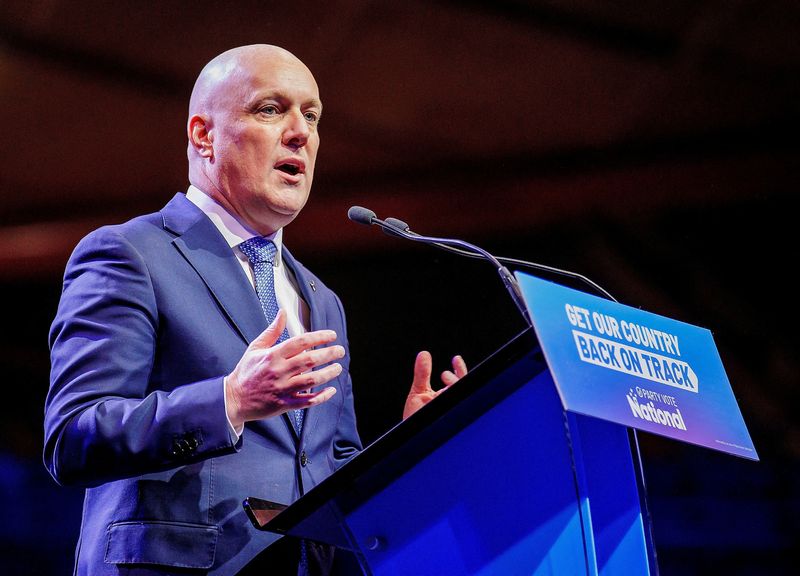
By Lucy Craymer
WELLINGTON (Reuters) - A National Party-led government has promised to cut government spending in New Zealand, reduce taxes and return the government accounts to surplus. But with coalition agreements yet to be sorted, there remain some questions about its economic policy.
WHAT DO WE KNOW?
Centre-right National won the biggest share of the vote in the general election on Oct. 14. With preferred coalition partner ACT New Zealand, it has a razor thin majority of just one seat. This could be eroded when the final vote is counted.
National is talking to both ACT and New Zealand First to get the numbers to form a government.
"All three want to rein in government spending, return to surplus, and reduce taxes. All three want to restore the tax deductibility of interest expenses for residential property investment, which is likely to immediately perk up investor interest in residential property," said ASB chief economist Nick Tuffley in a note.
GOVERNMENT DEBT
The Pre-election Fiscal Update forecast the government would record three more years of deficits in part due to the deterioration of the economy. Both National and ACT have committed to maintaining that track to surplus but want to reduce the size of deficits in each of those three-years.
To do so, National plans to cut spending on the public service by around NZ$600 million ($350 million) annually, while promising to boost spending on frontline staff in the health and education sectors.
ACT wants to go further. It has said it will scrap a number of ministries and axe around 15,000 public service jobs, reducing the headcount to levels seen in 2017.
TAX CUTS
National intends to allow foreigners to buy houses worth more than NZ$2 million but tax these purchases at 15%. It forecasts this will provide NZ$700 million more in revenue annually. This has been heavily debated by economists in New Zealand.
Both ACT and National want to reintroduce a tax break that lets property investors deduct some of their mortgage interest costs against what they pay on rental income taxes.
"Looser housing-related policy could add a bit of momentum to the housing market, and thereby possibly inflation and interest rates. But meaningful headwinds cap the upside," ANZ economists said in a note, pointing to high mortgage rates and affordability constraints.
CENTRAL BANK
National and ACT are both keen to return the central bank to focusing solely on inflation, rather than having a dual mandate that takes employment into consideration.
PARTY DIFFERENCES
Differences between the parties will be negotiated during coalition talks. Policies they differ on include immigration, raising the age that people receive an old-age benefit, and limiting foreign investment in New Zealand.
($1 = 1.7144 New Zealand dollars)
(This story has been refiled to correct the dateline to Oct. 19)

By Matt Spetalnick and Marianna Parraga
WASHINGTON (Reuters) - The Biden administration on Wednesday broadly eased sanctions on Venezuela's oil sector in response to a deal reached between the government and opposition parties for the 2024 election - the most extensive rollback of Trump-era restrictions on Caracas.
A new general license issued by the U.S. Treasury Department authorized OPEC member Venezuela, which had been under crushing sanctions since 2019, to produce and export oil to its chosen markets for the next six months without limitation.
U.S. Secretary of State Antony Blinken welcomed President Nicolas Maduro's electoral concessions but said Washington has given him until the end of November to begin lifting bans on opposition presidential candidates and start releasing political prisoners and "wrongfully detained" Americans.
A senior State Department official, speaking to Reuters on condition of anonymity, threatened to reverse sanctions relief measures unless Maduro takes such action.
The U.S. moves follow months of negotiations in which Washington had pressed Caracas for concrete actions toward democratic elections in return for lifting some - but not all - of the tough sanctions imposed under former U.S. President Donald Trump.
It also represents a significant step in the increased engagement of President Joe Biden's administration with Maduro on issues ranging from energy to migration, a shift from Trump's "maximum pressure" campaign against the socialist government.
Venezuela ruling party official Jorge Rodriguez, who leads the government's negotiating team at talks with the opposition, said on state television later on Wednesday that the sanctions relief affected all oil activities.
"The possibility of any person or company coming to Venezuela to invest is totally open," he said.
Maduro's government and the opposition reached an agreement in Barbados on Tuesday on electoral guarantees for an internationally monitored vote to be held in the second half of 2024. But the deal stopped short of Maduro agreeing to reinstate opposition candidates who had been barred from public office.
Blinken said in a statement that the U.S. was acting "consistent with our longstanding commitment to provide U.S. sanctions relief in response to concrete steps toward competitive elections and respect for human rights and fundamental freedoms."
Wednesday's announcements alleviated some of the toughest sanctions that Venezuela has faced but it left in place a number of other restrictions.
Even so, the U.S. measures could reopen Venezuela's doors to dozens of oil companies with frozen or reduced operations in Venezuela.
The U.S. imposed harsh sanctions on Venezuela to punish Maduro's government following his 2018 re-election, which the U.S. and other Western governments rejected as a sham. Since 2019, U.S. sanctions have banned state-run oil company PDVSA from exporting to its chosen markets.
TROUBLED VENEZUELAN OIL SECTOR
The changes announced on Wednesday include the issuance of a six-month general license allowing the production, sale and export of Venezuela's crude and gas, without limitations on customers or destinations, and another general license authorizing dealings with Minerven – the Venezuelan state-owned gold mining company.
The U.S. Treasury Department said in a statement, however, that it was prepared to revoke those authorizations at any time if representatives of Maduro fail to follow through on their commitments in the deal with the opposition.
Treasury also removed the secondary trading ban on certain Venezuelan sovereign bonds and state-run oil company PDVSA debt and equity, though a ban on trading in the primary Venezuelan bond market remains in place, it said.
The U.S. has been seeking ways to boost global flows of oil to alleviate high prices caused by sanctions on Russia and OPEC+ decisions to reduce output.
But the chances Venezuela's exports could offset those cuts are slim absent a big increase in investment in the country's crippled oil sector, oil industry experts said.
Two decades of mismanagement and insufficient investment, coupled with U.S. oil sanctions since 2019, are expected to stymie state-run PDVSA's ability to make a quick comeback to cash-paying oil markets and offer its crude at fair prices.
Talks between the government and the opposition, meant to provide a way out of Venezuela's long-running political and economic crisis, were held on Tuesday for the first time in nearly a year. They agreed to further meetings at an unspecified date.
The deal they announced said each side can choose its 2024 candidate according to its internal rules but did not reverse bans on some opposition figures - including Oct. 22 primary frontrunner Maria Corina Machado - that prevent them from holding office.
Opposition sources said they have not given up on trying to get those bans lifted.
(This story has been corrected to add the word 'next' in paragraph 2)
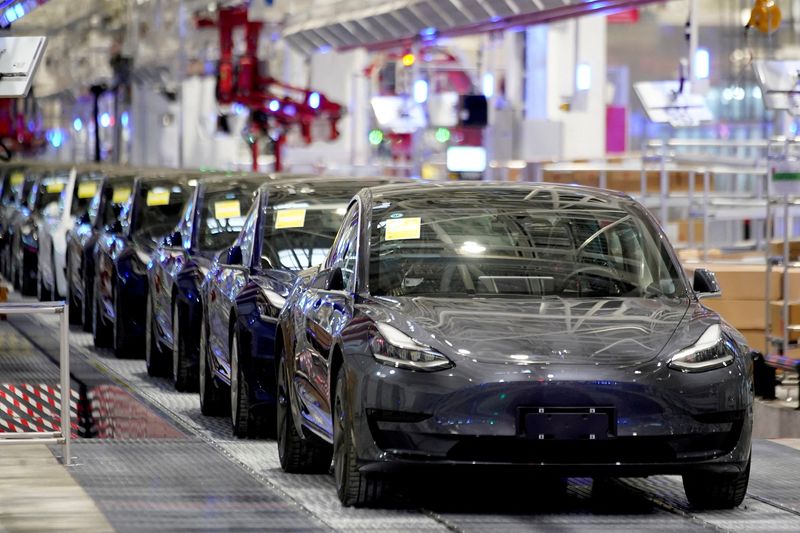
By Hyunjoo Jin, Akash Sriram and Joseph White
(Reuters) - Tesla (NASDAQ:TSLA) CEO Elon Musk said on Wednesday that he was concerned about the impact of high interest rates on car buyers, adding the electric vehicle maker was hesitating on its plans for a factory in Mexico as it gauges the economic outlook.
After the company missed Wall Street expectations on third-quarter gross margin, profit and revenue, Musk said he wanted to get a better sense of where the economy was headed before going "full tilt" on the Mexico factory.
"If interest rates remain high ... it's that much harder for people to buy the car. They simply can't afford it," he said on a conference call with analysts.
Tesla has managed to maintain demand with a series of price cuts, but Musk spent much of the call voicing concerns about further expansion, saying that he was afraid rising interest rates would make cars unaffordable.
The price of the popular Model Y SUV was "almost unchanged" for consumers even after Tesla's price cuts, Musk said, accounting for higher financing costs.
The automaker in March announced plans for a new factory in Mexico's northern state of Nuevo Leon that the state government estimated would cost more than $5 billion, though Tesla has yet to share a capital cost forecast.
Pressed for details on the factory, Musk said: "I am scarred by 2009 when General Motors (NYSE:GM) and Chrysler went bankrupt. I don't want to be going at top speed into uncertainty."
He also said there would be "enormous challenges" in reaching volume production for Tesla's long delayed Cybertruck pickup and making it cash flow positive.
Shares in the company fell 3% in after-hours trading on Wednesday. They had closed down 4.8%.
PRICE CUTS
Tesla's aggressive price cuts this year have battered its gross margin even as it faces stiff competition in China from local automakers.
The company is trying to survive the price war it started, mopping up any demand for electric cars in the market even as high interest rates and price tags at rivals mute EV sales. Some analysts have said it may need to cut prices further to achieve its annual production target .
In the third quarter ended September, gross margin fell to a more-than four-year low and the company signaled it would keep cutting production costs to boost profits.
Still, it stuck to its annual production target of 1.8 million cars, a sign that the price cuts were buoying demand to an extent.
Its stock has more than doubled this year as investors bet the company will fare better than rivals in an uncertain economy and get a long-term margin boost from its self-driving software, but scrutiny over its position in China, the world's largest auto market is rising.
"Tesla's worrying China sales figures indicate demand for its vehicles is slowing more than expected in the face of rising competition from local EV companies, including BYD (SZ:002594), Nio (NYSE:NIO), and XPeng (NYSE:XPEV)," said Jesse Cohen, senior analyst at Investing.com
"The big question is if this is just a blip, or signs of a bigger shift among consumers as rising interest rates and a weaker economic backdrop discourage consumers from making big-ticket purchases."
MARGIN FALLS
Tesla's gross margin dropped to 17.9% in the quarter ended September, compared with 25.1% a year earlier, when it had yet to start the price cuts. In the second quarter, Tesla had posted a gross margin of 18.2%.
Wall Street had on average expected Tesla to post a margin of 18.02%, according to 21 analysts polled by Visible Alpha. According to LSEG data, an average of 17 analysts polled expected 18.25%.
Automotive gross margin, excluding regulatory credits - a closely-watched figure - fell to 16.3% in the third quarter from 18.1% in the second quarter.
Margins fell despite a roughly $2,000 per vehicle reduction in raw material costs in the past quarter.
Tesla said its margin had taken a hit from the underutilization of new factories and an increase in operating expenses driven by its upcoming Cybertruck model as well as spending on artificial intelligence and other projects.
Revenue in the third quarter rose 9% to $23.35 billion, compared with analysts' estimates of $24.1 billion. That marked the slowest pace of growth in more than three years.
Its average revenue per unit declined by nearly 11% from a year earlier.
On an adjusted basis, Tesla earned 66 cents per share. Analysts had expected a profit of 73 cents per share, according to LSEG data. It was not immediately clear if the numbers were comparable.
Tesla said its energy business, which sells solar panels and batteries, as well as its services business, had become a meaningful contributor to profit with more than $500 million in combined gross profit in the quarter. (This story has been refiled to correct a typographical error in paragraph 4)

By Sarah Morland
(Reuters) -The Council of the European Union on Tuesday added the Indian Ocean island state of Seychelles and the Caribbean countries of Belize and Antigua and Barbuda to a list of 16 nations and territories deemed "non-cooperative" on taxes.
The council said all three jurisdictions either lacked tax information or failed to deliver on commitments regarding governance and transparency reforms.
The list also includes Russia, Panama, five other Caribbean states and territories and six in the Pacific Ocean.
The EU broadly asks its members to take the list into account for diplomatic and economic decisions, and commits to stronger monitoring for transactions or taxpayers linked to these countries, and bans channeling some EU funds through them.
The Council said in a statement the three new additions lacked a "largely compliant" rating from the OECD's Global Forum on Transparency and Exchange of Information for Tax Purposes, though Belize had made commitments to improve within the next year.
Belize's government blasted the move as an unjust "automatic" listing that disregarded reforms that addressed the Global Forum's July concerns, adding it will request an immediate review.
Barring Russia, it said in a statement, the EU list only includes "small and vulnerable countries like Belize yet fails to include any EU member state" which were given the same Global Forum rating.
"The EU's 'listing' process is devoid of the values of shared responsibility, mutual respect, accountability, fairness, and solidarity," the government said.
Oxfam's EU tax expert Chiara Putaturo also slammed the list as "toothless" for not screening the United States, the UK, or EU states such as Luxembourg and Malta, adding "countries deemed too big to be listed can no longer escape scrutiny."
The EU Council did not immediately respond to a request for comment.
The Council also removed the British Virgin Islands territory, the Marshall Islands and Costa Rica from the list.

The liquidity of the US Treasury market has largely rebounded following disruptions caused by the regional bank failures in March, including Silicon Valley Bank and Signature Bank (OTC:SBNY). This recovery came swiftly after a sudden liquidity plunge triggered by these failures, according to New York Fed economist Michael Fleming.
During the bank crisis in March, the bid-ask spread for all maturities expanded, with the 2-year note surpassing highs from the pandemic-induced crisis of March 2020. The availability of securities at the best level in the order book also decreased during this period.
Fleming's study used bid-offer spreads, order-book depth, and trade price impacts of recently auctioned two-, five-, and 10-year notes to illustrate the market's behavior. While five- and 10-year Treasuries aligned with expectations, two-year notes exhibited higher-than-expected price impacts due to market volatility.
The bank failures prompted significant reductions in Treasury yields, specifically for the two-year yield which experienced its most dramatic fall since 1982. However, these metrics improved within roughly a month after the bank failures.
Despite the initial disruption, the resilience of the US Treasury market has been demonstrated by its swift recovery from these recent events.
This article was generated with the support of AI and reviewed by an editor. For more information see our T&C.
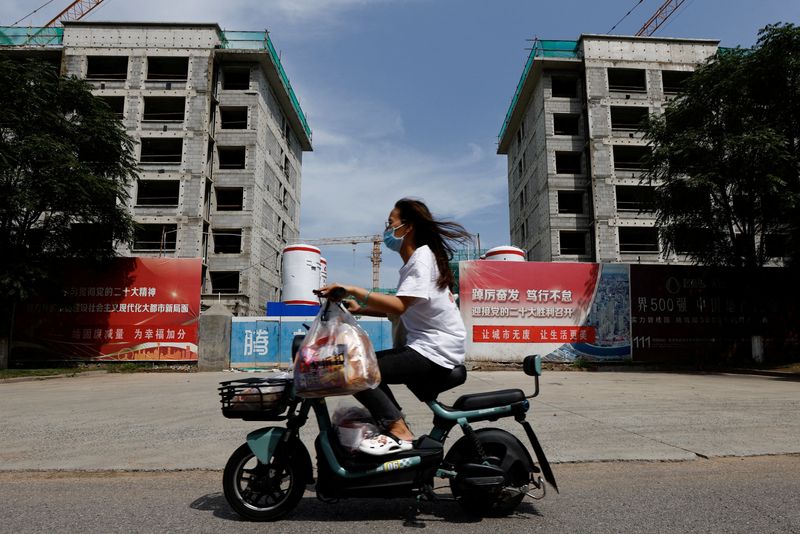
By Xinghui Kok
SINGAPORE (Reuters) - The International Monetary Fund (IMF) downgraded its 2023 and 2024 growth forecasts for China, saying its recovery was "losing steam" and citing weakness in its property sector.
The world's second-largest economy is expected to expand by 5% this year and 4.2% next year, down from 5.2% and 4.5% in the IMF's April forecast, the institution said in a regional economic outlook report released on Wednesday.
"In China, the recovery is losing steam, with manufacturing purchasing managers' indexes entering contracting territory from April to August and conditions in the real estate sector weakening further," said the report.
The report projected that a prolonged housing market correction in China would in the near-term "trigger greater financial stress among property developers and larger asset quality deterioration".
The impact of that could cause China's gross domestic product (GDP) to decline by as much as 1.6% percent relative to the baseline by 2025, while world GDP would decline by 0.6% relative to the baseline, it added.
The IMF's 2023 outlook for Asia and the Pacific was brighter, with IMF calling it "the most dynamic region this year".
The agency maintained its earlier growth projection for the region at 4.6% in 2023 and said economic activity in the region was on track to contribute around two-thirds of global growth this year.
Growth in Asia and the Pacific, however, is expected to slow to 4.2% next year. The IMF expects it to further moderate to 3.9% in the medium-term -- the lowest in the past two decades except for 2020 -- as China’s structural slowdown and weaker productivity growth in many other economies weigh on the region.
Disinflation was a bright spot for Asia, with the region excluding Japan expected to return to respective central bank inflation targets by the end of next year.
"This puts Asia ahead of the rest of the world, which, in general, will not see inflation returning to target until at least 2025," it said.
Central banks in the region, however, should guard against easing monetary policy prematurely, the IMF added.
"Central banks should carry through with policies to ensure that inflation is durably at appropriate targets. As tight monetary conditions can place strains on financial stability, strengthening financial supervision, vigilant monitoring of systemic risks, and modernising resolution frameworks are critical."

TUNIS (Reuters) - Tunisian President Kais Saied on Tuesday sacked Economy Minister Samir Saied after fresh statements that a deal with the International Monetary Fund (IMF) would be vital for obtaining other foreign financing.
The president strongly opposes what he described as the dictates of the IMF, saying that the IMF is "not sacred" and its conditions will lead to protests.
The minister told TAP state news agency on Tuesday that "lenders are wondering about Tunisia's talks with the IMF." adding that "any deal would give a strong signal to the rest of the financiers."
Tunisia last year reached a staff-level deal with the IMF for a $1.9 billion loan, but it has already missed key commitments and donors believe the state's finances are increasingly diverging from the figures the deal was based on.
The president criticized previous statements by the minister, saying that the government was charged with implementing the president's policy.
The president assigned Finance Minister Sihem Boughdiri to temporarily run the economy ministry.
Tunisia expects its economy to grow by 2.1% in 2024, up from 0.9% in 2023, and plans almost the same subsidies for fuel, electricity and food while raising taxes for banks, hotels and liquor firms, a bill on its budget showed on Tuesday.
The bill included no reference to an agreement with IMF.
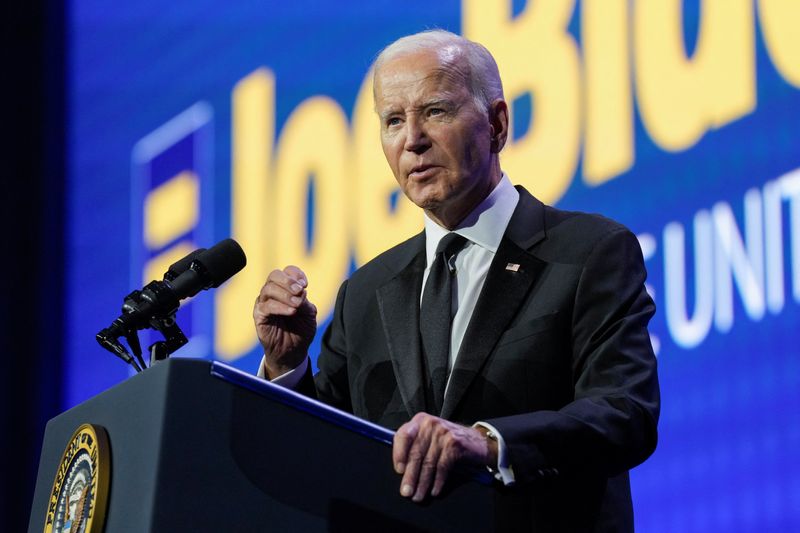
By Patricia Zengerle
WASHINGTON (Reuters) - U.S. Senate leaders said on Tuesday they expect President Joe Biden to send them a request by the end of this week for billions of dollars in assistance for Israel, Ukraine and Taiwan and for security at the U.S. border.
The size of the request was not known, but a congressional source familiar with the request said Israel had asked for $10 billion, as it responds to an attack on its citizens by the Iran-backed militant group Hamas.
Israel's request is not an indication that the Biden administration would request, or Congress would approve, that amount.
"We are going to do everything in our power to ensure the Senate delivers the support for Israel and the rest of the package. We intend to get the package the end of this week," the Senate's majority leader, Democratic Senator Chuck Schumer, told his weekly press conference.
The top Senate Republican, Senator Mitch McConnell, said he expected the request to include assistance for Israel, Ukraine and Taiwan, and said Republicans want it to include "something serious" for the border.
Top Biden administration officials will hold a classified briefing on Wednesday for the Senate on the situation in Israel and Gaza. Schumer said that Democratic Senator Bob Menendez, who faces charges of acting as an unregistered agent for Egypt, would not attend.
Menendez has denied wrongdoing.

